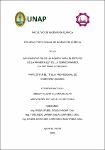| dc.contributor.advisor | Souza Nájar, Rosa Isabel | |
| dc.contributor.advisor | Salas Barrera, Fernando Javier | |
| dc.contributor.advisor | Carrasco Montañez, Daniel Diomedes | |
| dc.contributor.author | Alvarado Alva, Wendy Milena | |
| dc.contributor.author | Castillo Arteaga, Marvin Walter | |
| dc.date.accessioned | 2025-05-22T13:38:52Z | |
| dc.date.available | 2025-05-22T13:38:52Z | |
| dc.date.issued | 2025 | |
| dc.identifier.other | X | |
| dc.identifier.uri | https://hdl.handle.net/20.500.12737/11363 | |
| dc.description.abstract | The general objective of this thesis was to implement an equipment for the study of the first law of thermodynamics in closed systems, which consists of a three-layer cylinder, an electric resistance, an electric motor with agitator, a temperature controller, and two digital multimeters. The first law of thermodynamics was applied to deduce a model that allows evaluating the variation of internal energy of a liquid, which is related to the voltage and current of the electric resistance, the power of the electric motor, and the heat flow lost by the liquid. The samples used were 5.778 kg of papaya nectar and 5.806 kg of water. The heating of the papaya nectar lasted 660 s, and the variation of internal energy when applying the equations of Choi and Okos and the proposed model was 1.07717 ×106 J and 1.07048 ×106 J, respectively. The heating of water lasted 780 s, and the variation of internal energy when applying the equations of Choi and Okos and the proposed model was 1.26458 × 106 J and 1.26523 × 106 J, respectively. The minimum (0.05099 %) and maximum (0.6211 %) percentage error corresponded to water and papaya nectar, respectively, thus verifying that the proposed model allows evaluating the variation of internal energy of a liquid due to heating with great accuracy. Therefore, the general objective was achieved, and the general hypothesis was proven. | en_US |
| dc.description.abstract | El objetivo general de la presente tesis fue: implementar un equipo para el estudio de la primera ley de la termodinámica en sistemas cerrados, el cual está conformado por un cilindro de tres capas, una resistencia eléctrica, un motor eléctrico con agitador, un controlador de temperatura y dos multímetros digitales. Se aplicó la primera ley de la termodinámica para deducir un modelo que permite evaluar la variación de energía interna de un líquido, la cual se relaciona con el voltaje y el amperaje de la resistencia eléctrica, la potencia del motor eléctrico y el flujo de calor perdido por el líquido. Las muestras utilizadas fueron: 5.778 kg de néctar de papaya y 5.806 kg de agua. El calentamiento del néctar de papaya duro 660 s, por lo cual la variación de energía interna al aplicar las ecuaciones de Choi y Okos y dicho modelo resultó: 1.07717 × 106 J y 1.07048 ×106 J, respectivamente. El calentamiento del agua, tuvo una duración de 780 s, de modo que la variación de energía interna al aplicar las ecuaciones de Choi y Okos y dicho modelo resultó: 1.26458 × 106 J y 1.26523 × 106 J, respectivamente; por lo cual el mínimo (0.05099 %) y máximo (0.6211 %) error porcentual le corresponden al agua y al néctar de papaya, comprobándose de esta manera que el modelo deducido permite evaluar con gran exactitud la variación de energía interna de un líquido debido a un calentamiento. De este modo se cumplió con el objetivo general y simultáneamente se ha probado la hipótesis general. | es_PE |
| dc.format | application/pdf | es_PE |
| dc.language.iso | spa | es_PE |
| dc.publisher | Universidad Nacional de la Amazonía Peruana | es_PE |
| dc.rights | info:eu-repo/semantics/openAccess | * |
| dc.rights.uri | https://creativecommons.org/licenses/by/4.0/ | * |
| dc.subject | X | es_PE |
| dc.subject | X | es_PE |
| dc.subject | X | es_PE |
| dc.subject | X | es_PE |
| dc.title | Implementación de un equipo para el estudio de la primera ley de la termodinámica en sistemas cerrados | es_PE |
| dc.type | info:eu-repo/semantics/bachelorThesis | es_PE |
| thesis.degree.discipline | Ingeniería Química | es_PE |
| thesis.degree.grantor | Universidad Nacional de la Amazonía Peruana. Facultad de Ingeniería Química | es_PE |
| thesis.degree.name | Ingeniero(a) Químico(a) | es_PE |
| dc.subject.ocde | https://purl.org/pe-repo/ocde/ford#2.02.03 | es_PE |
| renati.author.dni | 71253473 | |
| renati.author.dni | 73043919 | |
| renati.advisor.orcid | https://orcid.org/0000-0002-7359-3332 | |
| renati.advisor.orcid | https://orcid.org/0000-0002-0177-3553 | |
| renati.advisor.orcid | https://orcid.org/0000-0002-2317-3911 | |
| renati.advisor.dni | 05231361 | |
| renati.advisor.dni | 05415003 | |
| renati.advisor.dni | 05339922 | |
| renati.type | https://purl.org/pe-repo/renati/type#tesis | es_PE |
| renati.discipline | 531026 | es_PE |
| renati.level | https://purl.org/pe-repo/renati/level#tituloProfesional | es_PE |
| renati.juror | Suarez Rumiche, Jorge Antonio | |
| renati.juror | Garcia Perez, Victor | |
| renati.juror | Garcia Navarro, Matsen Rolando | |
| dc.publisher.country | PE | es_PE |





